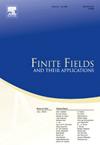关于Fq[x]的一个Erdős-type猜想
IF 1.2
3区 数学
Q1 MATHEMATICS
引用次数: 0
摘要
P. Erdős于1962年推测,在环Z上,Z上覆盖前2n个正整数的n个同余类的每一个集合也覆盖环Z。这一猜想于1970年由R. B. Crittenden和C. L. Vanden Eynden首次证实。后来,在2019年,P. Balister, B. Bollobás, R. Morris, J. Sahasrabudhe和M. Tiba提供了更透明的证据。本文采用R. B. Crittenden和C. L. Vanden Eynden的方法证明了有限域上多项式环集合中的广义Erdős猜想。我们证明了Fq[x]中覆盖所有阶数小于n的多项式的理想的n个余集的每一个集合覆盖环Fq[x]。本文章由计算机程序翻译,如有差异,请以英文原文为准。
On an Erdős-type conjecture on Fq[x]
P. Erdős conjectured in 1962 that on the ring , every set of n congruence classes in that covers the first positive integers also covers the ring . This conjecture was first confirmed in 1970 by R. B. Crittenden and C. L. Vanden Eynden. Later, in 2019, P. Balister, B. Bollobás, R. Morris, J. Sahasrabudhe, and M. Tiba provided a more transparent proof. In this paper, we follow the approach used by R. B. Crittenden and C. L. Vanden Eynden to prove the generalized Erdős' conjecture in the setting of polynomial rings over finite fields. We prove that every set of n cosets of ideals in that covers all polynomials whose degree is less than n covers the ring .
求助全文
通过发布文献求助,成功后即可免费获取论文全文。
去求助
来源期刊
CiteScore
2.00
自引率
20.00%
发文量
133
审稿时长
6-12 weeks
期刊介绍:
Finite Fields and Their Applications is a peer-reviewed technical journal publishing papers in finite field theory as well as in applications of finite fields. As a result of applications in a wide variety of areas, finite fields are increasingly important in several areas of mathematics, including linear and abstract algebra, number theory and algebraic geometry, as well as in computer science, statistics, information theory, and engineering.
For cohesion, and because so many applications rely on various theoretical properties of finite fields, it is essential that there be a core of high-quality papers on theoretical aspects. In addition, since much of the vitality of the area comes from computational problems, the journal publishes papers on computational aspects of finite fields as well as on algorithms and complexity of finite field-related methods.
The journal also publishes papers in various applications including, but not limited to, algebraic coding theory, cryptology, combinatorial design theory, pseudorandom number generation, and linear recurring sequences. There are other areas of application to be included, but the important point is that finite fields play a nontrivial role in the theory, application, or algorithm.

 求助内容:
求助内容: 应助结果提醒方式:
应助结果提醒方式:


